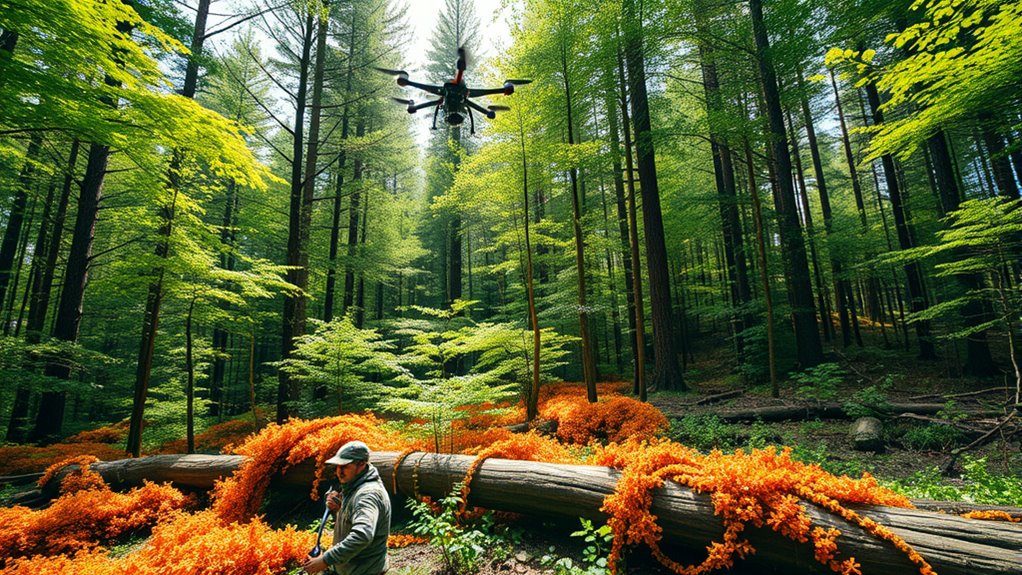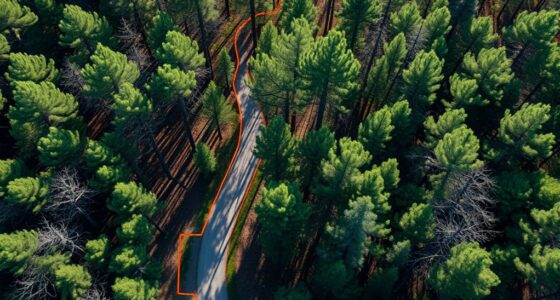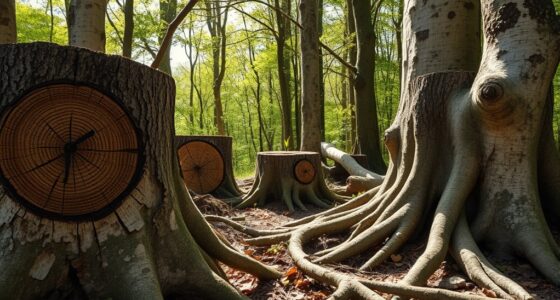Effective invasive species management in forests involves early detection, combined with mechanical, biological, and chemical control strategies. You can help by supporting community efforts, monitoring invasive plants and animals, and promoting native habitats. Using targeted removal methods and biological controls can reduce invasives without harming native species. Innovative technologies like drones and genetic tools are shaping future approaches. If you keep exploring, you’ll discover more ways to protect and restore forest ecosystems.
Key Takeaways
- Early detection and rapid response are critical to prevent invasive species from establishing in forest ecosystems.
- Mechanical removal, physical barriers, and chemical controls help manage invasive plants in forests effectively.
- Biological control using natural enemies offers targeted, environmentally friendly methods for invasive species suppression.
- Advanced technologies like drone surveillance, satellite imaging, and genetic tools enhance detection and monitoring efforts.
- Community engagement and ecological restoration are essential for long-term invasive species management in forest environments.
Understanding the Impact of Invasive Species on Forest Ecosystems

Invasive species can dramatically alter forest ecosystems by outcompeting native plants and animals for resources. They often arrive via invasive species pathways, such as cargo shipments or disturbed land, bypassing natural barriers. Some invasive plants and animals are linked to genetic modification, either intentionally or accidentally, which can enhance their adaptability and survival. This increased resilience allows them to spread rapidly, displacing native species and disrupting ecological balances. As they establish themselves, invasive species can change nutrient cycling, soil composition, and habitat availability. Understanding these impacts helps you recognize how invasive species threaten biodiversity and ecosystem stability. Monitoring invasive species pathways and understanding their genetic traits are essential steps in managing their spread and protecting forest health.
Key Challenges in Controlling Non-Native Species
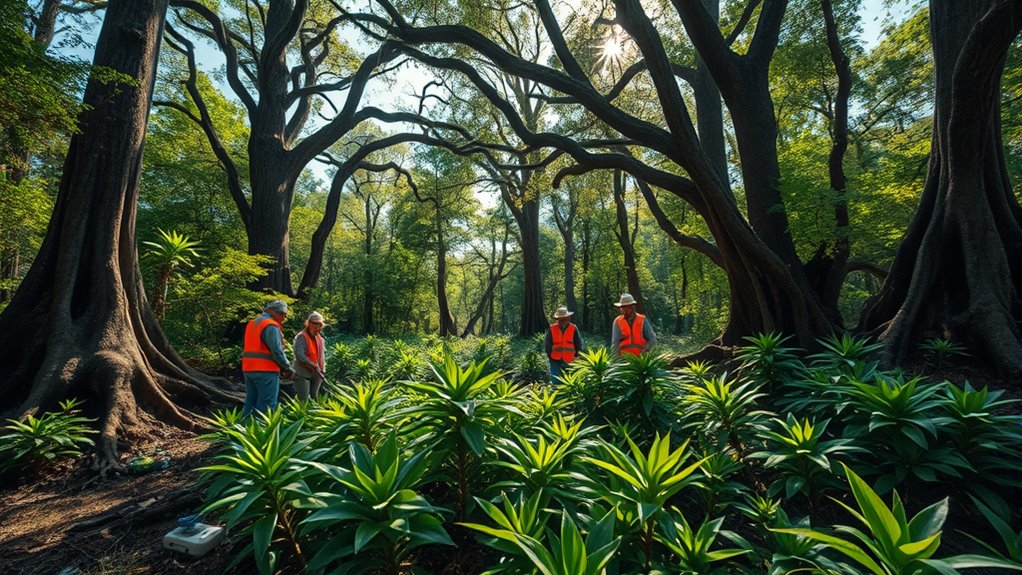
Controlling non-native species presents numerous challenges because these organisms often adapt quickly and spread beyond initial containment efforts. Their rapid growth can hinder habitat restoration efforts, making it difficult to re-establish native species effectively. Non-native plants and animals may outcompete native species for resources, leading to reduced biodiversity. Additionally, these species often establish extensive networks, complicating eradication efforts. You must also consider that some invasive species are resilient to conventional control methods, requiring ongoing management. Restoring native habitats becomes a complex task when invasive species dominate, as it’s hard to reintroduce native species without them being quickly displaced again. Moreover, understanding the ecology of the habitat is crucial for developing effective control strategies. Effective management also depends on understanding the spread mechanisms of invasive species to prevent further proliferation. Recognizing the importance of aesthetic wall organization and other home decor principles can inspire innovative approaches to habitat management and restoration. Incorporating monitoring technologies can enhance detection and control efforts, leading to more successful eradication. Additionally, applying integrated pest management strategies that combine biological, chemical, and mechanical methods can improve long-term control outcomes. Overall, these challenges demand persistent, adaptive strategies to protect forest ecosystems and promote the recovery of native species populations.
Methods of Mechanical and Physical Removal
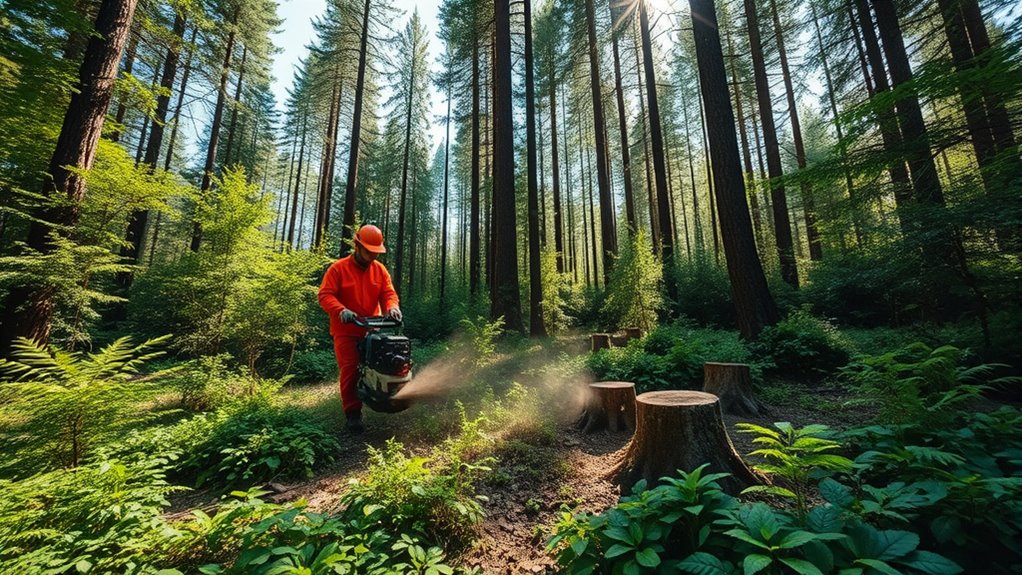
When addressing the challenges posed by non-native species, physical and mechanical removal methods offer immediate and tangible solutions. Manual removal involves physically pulling or digging out invasive plants, which is effective for smaller infestations or delicate areas. It requires careful effort but minimizes environmental impact. Physical barriers, such as fencing or mesh, prevent the spread of invasives by blocking seed dispersal or access to sensitive areas. Installing these barriers is especially useful for protecting native species and controlling invasive growth. Both methods demand ongoing maintenance and labor, but they can considerably reduce invasive populations without chemicals. Using manual removal and physical barriers together creates a proactive approach, helping to contain and manage invasives while supporting native biodiversity.
Biological Control Strategies and Their Effectiveness
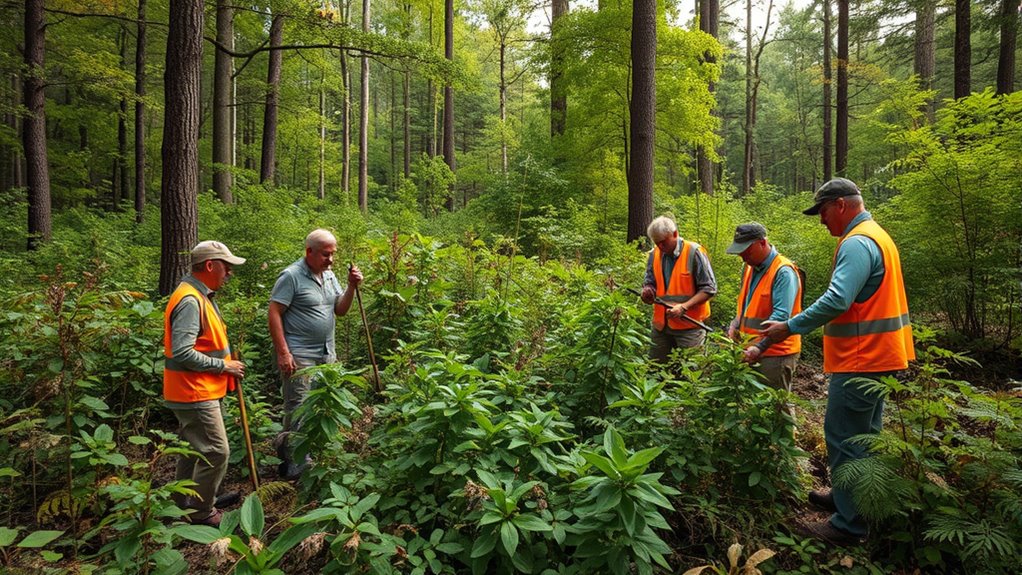
Biological control strategies harness natural enemies or competitors to suppress invasive species populations effectively. They use predators, pathogens, or competitors to achieve biological suppression, reducing reliance on chemicals. Some methods involve genetic modification of natural enemies to improve targeting or effectiveness. These strategies can be highly specific, minimizing impacts on native species, but their success varies. Carefully studied introductions are essential for safety and success. Additionally, understanding sound healing science can inform more holistic approaches to ecosystem management. For example, integrating ecosystem-based approaches can enhance the sustainability of biological control efforts. Moreover, the use of biological diversity in natural enemy populations can improve resilience and adaptability of control measures. Incorporating behavioral ecology insights can further optimize biological control methods. Employing integrated pest management strategies that combine biological control with other techniques can improve overall effectiveness. While promising, biological control requires ongoing monitoring to prevent unintended consequences. When implemented properly, these strategies offer sustainable management options for invasive forests.
The Role of Chemical Treatments in Managing Invasives

Chemical treatments play a essential role in managing invasive species by directly targeting and eliminating problematic populations. You can use pesticide application to control invasive plants effectively, reducing their spread and impact on native species. Chemical barriers are also valuable, creating a physical and chemical obstacle that prevents invasives from advancing into new areas. These treatments allow for precise intervention, especially in areas where manual removal is impractical. When applied carefully, pesticides can suppress invasive growth without harming native plants, but you must follow recommended guidelines to minimize environmental impact. Additionally, understanding the vetted Halloween product reviews can help in selecting suitable tools and protective gear for chemical application. Overall, chemical treatments are a crucial part of integrated management strategies, providing quick and targeted control to protect forest ecosystems from invasive threats.
Early Detection and Rapid Response Techniques
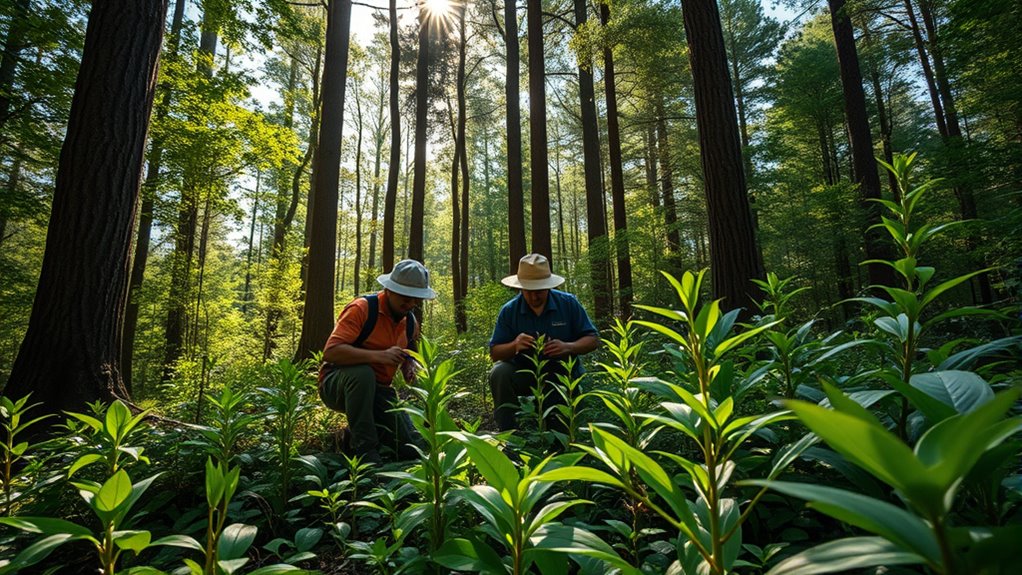
You can improve invasive species management by using advanced monitoring technologies that quickly identify new threats. Once detected, swift intervention strategies help prevent their spread and minimize damage. Implementing these techniques guarantees you respond effectively and protect your ecosystem.
Monitoring Technologies Utilized
Advances in monitoring technologies have revolutionized how you detect invasive species early and coordinate rapid responses. Drone surveillance allows quick, targeted inspections of hard-to-reach areas, providing real-time imagery. Satellite imaging offers broad-scale monitoring, revealing changes in forest health and early signs of invasions. These tools enable you to identify infestations sooner, saving time and resources. Incorporating high refresh rates in drone and satellite data collection can further improve the timeliness and accuracy of detection efforts. Additionally, integrating data analytics can help interpret large datasets more effectively, leading to more informed management decisions. Employing integrated monitoring systems enhances the overall effectiveness of invasive species management in complex forest environments.
Swift Intervention Strategies
When invasive species are detected early, swift intervention is essential to prevent widespread damage. Rapid response techniques include targeted removal, quarantine measures, and genetic modification to control or eradicate the invaders. Genetic modification can help develop sterile or less adaptable strains, reducing their spread, while climate adaptation strategies improve native species’ resilience to invasion. You should act quickly to implement these measures, as delays allow invasives to establish and expand. Monitoring data guides decisions, ensuring interventions are timely and effective. In addition, early detection methods play a crucial role in catching invasives before they become unmanageable, emphasizing the importance of regular surveillance. In some cases, integrating genetic tools with traditional methods enhances control success. Additionally, understanding the subconscious power during sleep can aid in fostering a mindset of proactive environmental stewardship. By responding rapidly, you minimize ecological disruption, protect native biodiversity, and maintain forest health. Swift action, informed by technology and climate considerations, is key to effective invasive species management. Incorporating Glycolic Acid benefits into regular monitoring can also improve native plant health and resilience, supporting overall ecosystem stability. Moreover, leveraging Gold IRA investment principles can provide financial resources to fund invasive species eradication programs. Recognizing the importance of personal finance strategies can ensure the long-term sustainability of conservation efforts.
Community Engagement and Public Awareness Initiatives
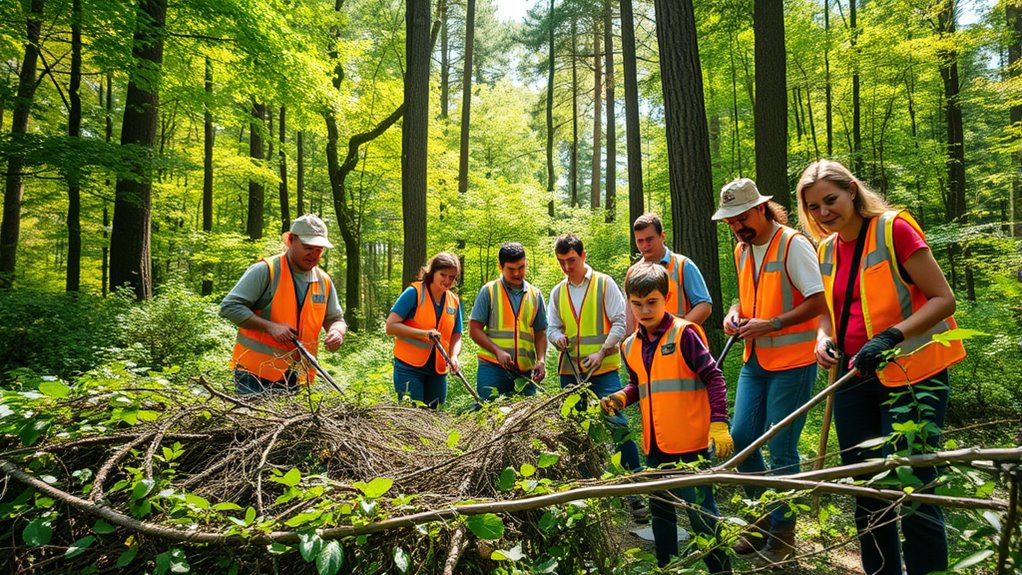
Engaging your community through local outreach strategies can considerably boost awareness about invasive species. Educational campaigns often lead to increased volunteer participation and stronger support for management efforts. By focusing on effective communication, you can turn public awareness into meaningful action. Additionally, involving local expertise and fostering community collaboration can significantly enhance the effectiveness of invasive species management initiatives. Promoting understanding of native habitat preservation can also motivate community members to participate actively in conservation efforts. Recognizing the importance of public involvement can further help in building a collective commitment to ecological health and sustainable management practices.
Local Outreach Strategies
Have you ever wondered how local communities can play a vital role in controlling invasive species? You can make a difference by engaging in native plant restoration and supporting policy advocacy efforts. To maximize impact, consider these strategies:
- Organize neighborhood invasive species removal events
- Promote native plant gardening to reduce invasive spread
- Collaborate with local authorities to strengthen policies
- Distribute informational materials on invasive risks
- Foster community-led monitoring programs
These efforts raise awareness and empower residents to take action. When communities understand the importance of native plant restoration, they help restore natural balance. Supporting policy advocacy ensures long-term changes that limit invasive species introduction. By actively participating in outreach, you help protect forest ecosystems and ensure sustainable management of invasive species at the local level.
Educational Campaigns Effectiveness
Effective educational campaigns substantially boost community involvement in invasive species management by increasing awareness and motivating action. When you highlight the importance of native flora, you help people understand how invasive species threaten local ecosystems. Public awareness initiatives can also address how climate change exacerbates invasive spread, making early intervention *vital*. To gauge effectiveness, consider this table:
| Campaign Focus | Impact |
|---|---|
| Native flora education | Encourages planting native species, reducing invasive spread |
| Climate change links | Highlights urgency, fostering proactive community response |
| Community workshops | Builds local knowledge and stewardship |
Volunteer Participation Growth
Community engagement plays a crucial role in expanding volunteer participation in invasive species management. When you involve local communities, you foster a sense of ownership that drives native plant restoration and strengthens habitat connectivity. To boost involvement, consider these strategies:
- Organize hands-on invasive removal events that highlight native species
- Educate volunteers on the importance of habitat connectivity for ecosystem health
- Promote native plant restoration projects through social media and local outreach
- Create partnerships with schools and community groups to build awareness
- Recognize volunteer efforts to maintain motivation and ongoing participation
Integrating Management Approaches for Sustainable Outcomes
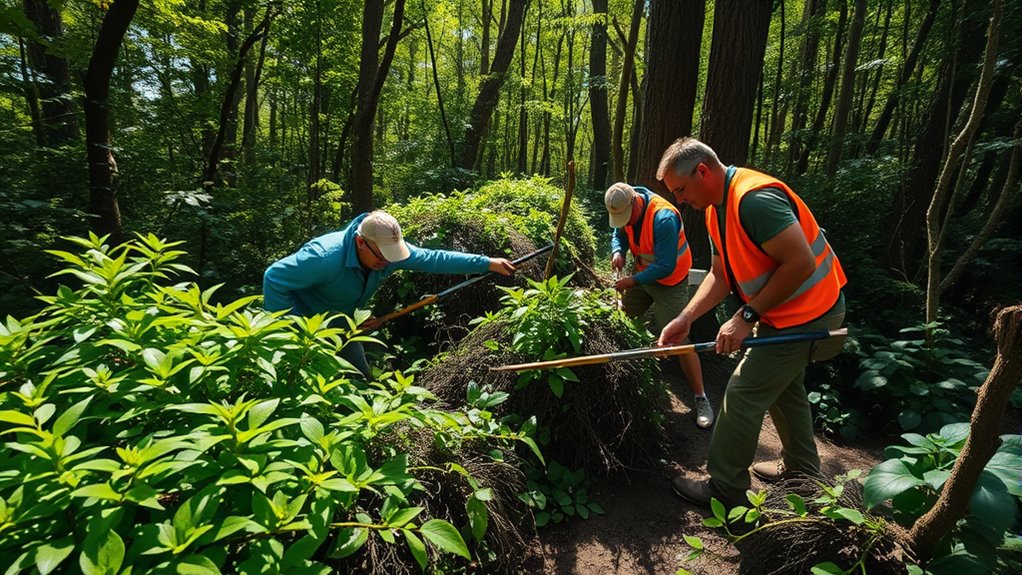
To achieve sustainable outcomes in invasive species management, integrating multiple approaches is essential. Combining methods like habitat restoration with innovative tools such as genetic modification can enhance effectiveness. Habitat restoration helps rebuild native ecosystems, making them more resilient against invasives. Meanwhile, genetic modification can be used to develop targeted control strategies, reducing reliance on chemicals or broad-spectrum methods. By coordinating these techniques, you can address invasive threats holistically, promoting long-term health of forest ecosystems. This integration allows for adaptive management, where strategies are adjusted based on ongoing results. Ultimately, blending traditional practices with cutting-edge science ensures a more sustainable, efficient, and environmentally friendly approach to controlling invasive species.
Future Directions and Innovations in Invasive Species Control
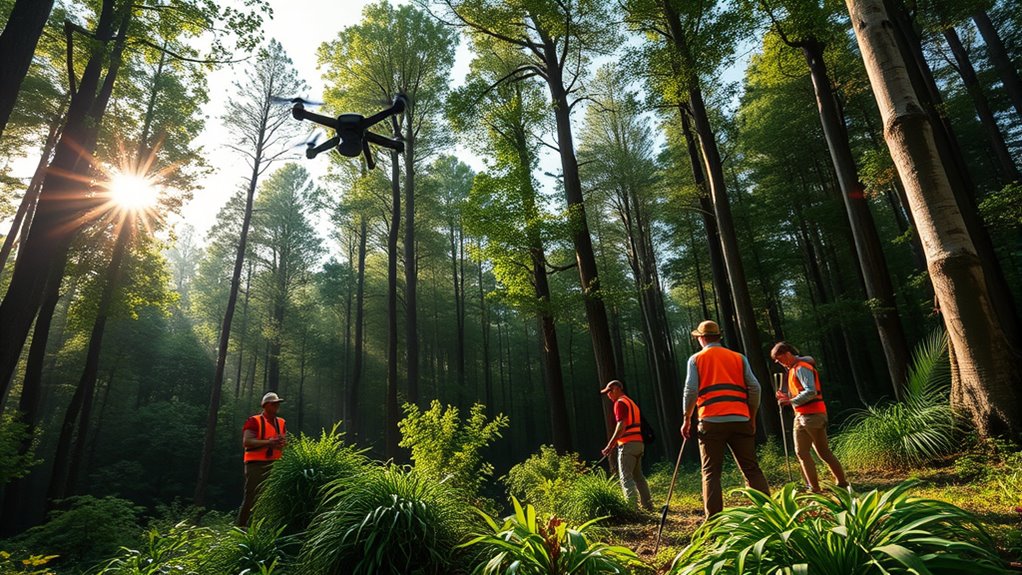
What does the future hold for invasive species control as technology advances? You can expect innovative strategies to emerge, driven by genetic engineering and climate adaptation. These advancements could allow you to develop targeted biocontrol agents or modify invasive species’ genomes to reduce their impact. Climate change will also shape future efforts, requiring adaptive methods that respond to shifting ecosystems. You might see:
Future invasive species control will harness gene editing, AI monitoring, and climate-adaptive strategies for more effective management.
- Precision gene editing to weaken invasive populations
- Use of genetically modified organisms for targeted suppression
- Climate-resilient control methods to address changing habitats
- AI-powered monitoring for early detection and rapid response
- Integration of genetic and ecological data to refine management plans
Together, these innovations will help you manage invasions more effectively, minimizing ecological disruption while adapting to a rapidly changing environment.
Frequently Asked Questions
How Do Invasive Species Spread Across Different Forest Regions?
You might wonder how invasive species spread across forest regions. They often disperse through seed dispersal, carried by wind, water, or animals. Human activity markedly accelerates this process, whether through logging, hiking, or transport of plants and soil. These actions unintentionally introduce invasive seeds into new areas, helping them establish quickly. Staying aware of these pathways helps prevent further spread and protects forest ecosystems from invasive threats.
What Economic Impacts Do Invasive Species Have on Forestry Industries?
Invasive species cause significant economic loss and industry disruption in forestry. You might see reduced timber yields, increased control costs, and damage to valuable resources. These impacts strain your industry’s profitability and can lead to job losses. As invasive species spread, they threaten not only forest health but also your community’s economic stability, emphasizing the urgent need for effective management to protect forestry industries from ongoing and future threats.
Are There Native Species That Can Naturally Control Invasives?
Imagine nature as a balanced scale; native predators act as the weight that keeps invasive species in check. You can harness natural forces through biological control, relying on native species that hunt or compete with invasives. This approach promotes ecosystem health, reduces chemical use, and fosters sustainable management. By understanding and supporting these native controls, you help restore balance and protect forests from invasive threats naturally.
What Role Does Climate Change Play in Invasive Species Proliferation?
Climate change accelerates invasive species proliferation by causing climate-induced migration, allowing non-native species to expand into new areas. Rising temperatures drive growth rates of invasives, enabling them to outcompete native plants. You’ll notice shifts in ecosystems as invasive species adapt quickly to changing conditions, disrupting balance. Managing these threats requires understanding how climate factors influence invasives’ spread, so you can develop effective strategies to protect native biodiversity.
How Can Policymakers Support Invasive Species Management Efforts?
You can support invasive species management efforts by advocating for clear funding priorities that allocate resources effectively. Raising public awareness is also vital, as it encourages communities to participate in prevention and early detection. Policymakers should develop policies that promote education, support research, and foster collaboration among stakeholders. Your involvement helps guarantee these initiatives receive the attention and resources needed to protect ecosystems from invasive threats.
Conclusion
Remember, an ounce of prevention is worth a pound of cure. By staying vigilant, engaging communities, and employing integrated management strategies, you can protect your forests from invasive species. Embrace new technologies and early detection methods to stay ahead of threats. Together, you can preserve the health and biodiversity of your forests for generations to come. Don’t wait until it’s too late—act now to safeguard these crucial ecosystems.
